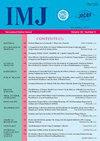新型冠状病毒病的临床及并发症与发病机制
Q4 Medicine
引用次数: 1
摘要
新冠肺炎疫情持续的时间越长,有关其临床表现的信息就积累得越多。新冠肺炎-19的潜伏期为2至14天,很少长达3周,但在相当多的病例中,感染并不伴随临床症状的出现。目前,新冠肺炎−19临床病程的以下变体可鉴定如下:病毒载量;亚临床;轻微的仅对上呼吸道无损伤;轻度肺炎、严重肺炎、急性呼吸窘迫综合征等。COVID-19的临床病程取决于严重程度,其标准是中毒表现、发烧程度和显性综合征。轻度/中度表现为体温频繁升高至38°C、呼吸道症状、头痛、肌痛、心悸和全身不适。患者不再辨别气味,而是感觉食物的味道。大约在疾病的第7天至第9天出现呼吸问题,这表明下呼吸道受损和疾病第二阶段的开始,其病程被视为严重。严重的疾病还可以表现为运动协调性受损、口齿不清。1%至4%的患者出现幻觉形式的精神病。在老年人中,新冠肺炎−19可能伴有谵妄,降低血压。不良疾病的风险与躯体疾病有关:心血管和神经系统、呼吸道、激素紊乱等。中耳炎、鼻窦炎、败血症、支气管肺感染、血栓形成、心肌炎等可能是COVID-19的并发症。计算机断层扫描是一种仪器测试,可以证明冠状病毒对肺部的损伤,并可以评估其严重程度。关键词:冠状病毒感染,新冠肺炎−19,临床变异,严重程度,肺炎,急性呼吸窘迫综合征。本文章由计算机程序翻译,如有差异,请以英文原文为准。
CLINIC AND COMPLICATIONS OF COVID-19 CORONAVIRUS DISEASE WITH PATHOGENESIS ELEMENTS
The longer the COVID−19 coronavirus pandemic lasts, the more information about its clinical manifestations is accumulated. The incubation period of COVID−19 ranges from 2 to 14 days, rarely up to 3 weeks, but in a significant number of cases an infection is not accompanied with the appearance of clinical symptoms. Currently, the following variants of the clinical course of COVID−19 can be identified as follows: viral load; subclinical; slight; uncomplicated with damage to only the upper respiratory tract; mild pneumonia, severe pneumonia, acute respiratory distress syndrome, etc. The clinical course of COVID−19 depends on the severity, the criteria of which are the intoxication manifestation, the degree of fever and the dominant syndrome. Mild / moderate forms are manifested by frequent increase in body temperature up to 38 ° C, respiratory symptoms, headache, myalgias, palpitations and general malaise. Patients stop distinguishing smells and feel the taste of food. Approximately from the 7th to the 9th days of the disease there are problems with breathing, which indicates the impairment of the lower respiratory tract and the beginning of the second phase of the disease, and its course is regarded as severe. Severe forms of the disease can also be manifested by impaired coordination of movements, slurred speech. In 1 to 4 % of patients there is developed the psychosis in the form of hallucinations. In the elderly, COVID−19 may be accompanied by delirium, lowering blood pressure. The risks of adverse disease are associated with somatic diseases: cardiovascular and nervous systems, respiratory tract, hormonal disorders, etc. Otitis, sinusitis, sepsis, bronchopulmonary infection, thrombosis, myocarditis etc. can be the complications of COVID−19. Computer tomography is an instrumental test that demonstrates the damage of lungs with coronavirus and allows to assess its severity.
Key words: coronavirus infection, COVID−19, clinical variants, severity, pneumonia, acute respiratory distress syndrome.
求助全文
通过发布文献求助,成功后即可免费获取论文全文。
去求助
来源期刊

International Medical Journal
医学-医学:内科
自引率
0.00%
发文量
21
审稿时长
4-8 weeks
期刊介绍:
The International Medical Journal is intended to provide a multidisciplinary forum for the exchange of ideas and information among professionals concerned with medicine and related disciplines in the world. It is recognized that many other disciplines have an important contribution to make in furthering knowledge of the physical life and mental life and the Editors welcome relevant contributions from them.
The Editors and Publishers wish to encourage a dialogue among the experts from different countries whose diverse cultures afford interesting and challenging alternatives to existing theories and practices. Priority will therefore be given to articles which are oriented to an international perspective. The journal will publish reviews of high quality on contemporary issues, significant clinical studies, and conceptual contributions, as well as serve in the rapid dissemination of important and relevant research findings.
The International Medical Journal (IMJ) was first established in 1994.
 求助内容:
求助内容: 应助结果提醒方式:
应助结果提醒方式:


